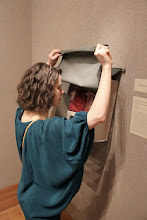Georgia O’Keefe, The Calendar Girl
Georgia O’Keefe has become an artist reduced to cliché, her images repetitively reproduced on postcards and calendars to a visually numbing effect. Her symbolic imagery of flowers reduced to a shallow sexual quip. Our eyes have become accustomed to repetitive viewing in banal contexts, sucking the juicy and complex content of O’Keefe’s work dry.
Luckily the exhibition of O’Keefe’s work at the Whitney last September
attempted to revive her, breathing fresh life into her images. The format of the show emphasized the artist’s intention by way of the interior and exterior. Her paintings were interspersed between portraits taken of her by Stieglitz, her lover at the time. Perhaps because he was privy to an intimate angle of her he was able to take arresting portraits. In his photographs her exterior demanded attention, exuding strength and character and a stubborn temperament.
Alternatively though not in contradiction her interior was made present through the energetic abstractions. Art, whether abstraction or otherwise is the intangible made tangible. The invisible visible. O’Keefe articulated frankly through shapes and color, her (though these words don’t suffice) feelings, desires and internal energies. Abstraction was simply the only kind of art, she said, that let her express her deepest feelings.1
Although secretly I curse whoever introduced her to oil. Her early watercolor paintings flowed with a freedom lost in the muddy stiffness of the oil paintings. She struggled with color and value in the oil medium when she may have breezed through shading with water-based washes. I shudder to imagine what easy power she may have released had she stuck to watercolor. Though a second thought wonders if the rigidity with which she handled oil was better suited to a stubborn, rock/bone-like character? Did her freedom of form lie in the rigid structure of line?
Articulation is courageous both if everyone understands and if no one understands. Because O’Keefe did not explain in words the origins of her artistic instigations, Stieglitz and others located meaning in sexual cliché’s of generic womanness. No doubt sexuality in a woman is fierce, but in speaking of energies in the body, it is one of many. Referred to as chakras in yoga or as spiritual reservoirs of energy which are all tangled together. There is something scarily minimizing about relating O’Keefe’s paintings to mere genitalia or singular sexual pleasure.
But how then does one address in words that interior world without sounding like a sappy fool? Is this interior world of unconscious instincts, fantasized nuances and spiritual swinging colliding with sensory information coming from outside and in, even worth talking about? The most brazen articulation of this inner sense is in O’Keefe’s paintings, as long as the viewer doesn’t think it out but rather feels it out, painting by painting.
1 Holland Cutter, In Full Flower, Before the Desert, The New York Times, September 17, 2009
Friday, May 21, 2010
Subscribe to:
Post Comments (Atom)

No comments:
Post a Comment